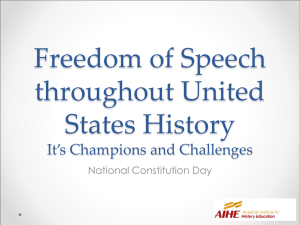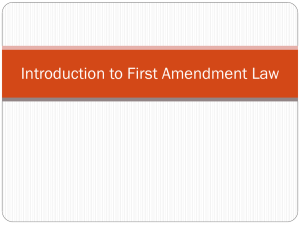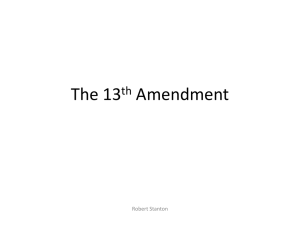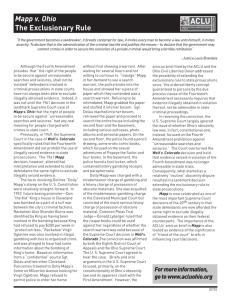Gallery Walk Amendment Court Cases
advertisement
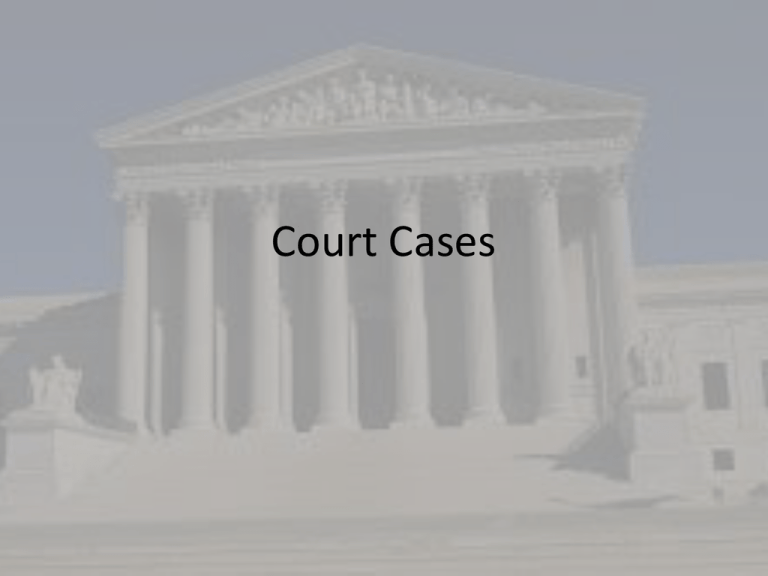
Court Cases Marbury v. Madison (1803) • Marbury tried to force Madison to give him appointment as judge • Established Judicial Review (the Supreme Court claimed its right to declare acts of the Legislative and Executive Branches unconstitutional) • Allowed other cases to reach the Supreme Court McCulloch v. Maryland (1819) • Maryland tried to tax the national government’s banks • Strengthened national supremacy and gave congress implied powers • Enforces Supremacy Clause Gallery Walk Amendment Court Cases Texas v. Johnson (1989) • Man burned a flag at a rally and was arrested • Flag burning is constitutional; Protects symbolic Gregory Lee Johnson burned an American flag outside of the speech convention center where the 1984 Republican National • Strengthened 1st Convention was being held in Dallas, Texas. Johnson burned the flag to protest the policies of President Ronald Reagan. Amendment He was arrested and charged with violating a Texas statute that prevented the desecration of a venerated object. A Texas court tried and convicted Johnson. He appealed, arguing that his actions were "symbolic speech" protected by the First Amendment. Mapp v. Ohio (1961) •Mapp’s home was searched without warrant and she went to jail • Exclusionary rule—must throw out bad evidence found without a warrant • Enforces 4th Amendment (unreasonable search and seizure) Police believed that Mapp was harboring a suspected bomber, and demanded entry. No suspect was found, but police discovered a trunk of obscene pictures in Mapp's basement. Mapp was arrested for possessing the pictures, and was convicted in an Ohio court. Mapp argued that her Fourth Amendment rights had been violated by the search In Re Gault (1967) • Juvenile was not given due process rights in trial; questioned without parents; forced confession • Gives juveniles the same due process rights as adults • 5th Amendment (Due process of law) Gerald (“Jerry”) Gault was a 15 year-old accused of making an obscene telephone call to a neighbor, Mrs. Cook, on June 8, 1964. After Mrs. Cook filed a complaint, Gault and a friend, Ronald Lewis, were arrested and taken to the Children’s Detention Home. Gault was on probation when he was arrested, after being in the company of another boy who had stolen a wallet from a woman’s purse. At the time of the arrest related to the phone call, Gault’s parents were at work. The arresting officer left no notice for them and did not make an effort to inform them of their son’s arrest. Miranda v. Arizona (1966) •Man was NOT told he had the right to remain silent or a lawyer • Established Miranda Rights that had to be read before trials • 5th and 6th Amendments Miranda was arrested at his home and taken in custody to a police station where he was identified by the complaining witness. He was then interrogated by two police officers for two hours, which resulted in a signed, written confession. At trial, the oral and written confessions were presented to the jury. Miranda was found guilty of kidnapping and rape and was sentenced to 20-30 years imprisonment on each count. On appeal, the Supreme Court of Arizona held that Miranda’s constitutional rights were not violated in obtaining the confession. Gideon v. Wainwright (1963) • Gideon could not afford a lawyer so he defended himself and lost •All people have the right to a lawyer no matter how much money they make • Enforces 5th and 6th Amendment Gideon was charged with breaking and entering with the intent to commit a misdemeanor, which is a felony under Florida law. At trial, Gideon appeared in court without an attorney. In open court, he asked the judge to appoint counsel for him because he could not afford an attorney. The trial judge denied Gideon’s request because Florida law only permitted appointment of counsel for poor defendants charged with capital offenses. Furman v. Georgia (1972) •Death penalty was cruel and unusual punishment because it favored black males • Death penalty was UNconstitutional • 8th Amendment Furman was burglarizing a private home when a family member discovered him. He attempted to flee, and in doing so tripped and fell. The gun that he was carrying went off and killed a resident of the home. He was convicted of murder and sentenced to death . Gregg v. Georgia (1976) •Gregg said death penalty was unconstitutional because of Furman • Death penalty IS constitutional if it follows fair and consistent rules • **Overturned Furman vs. Georgia • 8th Amendment A jury found Gregg guilty of armed robbery and murder and sentenced him to death. On appeal, the Georgia Supreme Court affirmed the death sentence except as to its imposition for the robbery conviction. Gregg challenged his remaining death sentence for murder, claiming that his capital sentence was a "cruel and unusual" punishment that violated the Eighth and Fourteenth Amendments. Other Court Cases Gibbons v. Ogden (1824) • Questioned who had control of interstate trade for steam boat trading • Gave the Federal Government sole power to regulate all possible forms of commerce between the states/Strengthened National Government power In this case Thomas Gibbons -- a steamboat owner who did business between New York and New Jersey under a federal coastal license -- challenged the monopoly license granted by New York to Aaron Ogden. New York courts consistently upheld the state monopoly. Proved a federal license is greater than a state license Dred Scott vs. Sanford •Dred Scott was a slave whose master moved him from Missouri to a free state (Illinois) and then back to Missouri. When the master died, Scott sued for his freedom since he lived in a free state. •Supreme Ruled that since Scott was black he did not have the right to sue in court and if a person. They further stated that if a person was a slave they were personal property. •This is why we have the 14th Amendment Plessy v. Ferguson (1896) •Plessy sat on an all white train and was arrested because he was 1/8 black •Legalized segregation •Supreme Court Ruled “separate, but equal” is OK Brown v. Board of Education (1954) *Brown wanted his daughter to go to a closer all white school *Desegregated schools, blacks and whites could go to same school OVERTURNS PLESSY VS. FERGUSON Swann v. CMS (1971) • Schools in CMS were still segregated because neighborhoods were segregated • Used busing to force desegregation in Charlotte Schools Korematsu v. US (1944) • Korematsu refused to go to a Japanese internment camp and was arrested • Allowed government to take people’s rights away in times of war The Korematsu decision was significant because it ruled that the United States government had the right to exclude and forcibly move people from designated areas based on their race. The decision was 6-3 that the need to protect the United States from espionage and other wartime acts was more important than Korematsu's individual rights. Even though Korematsu's conviction was eventually overturned in 1983, the Korematsu ruling concerning the creation of exclusion orders has never been overturned. US vs. Nixon Pres. Nixon installed a taping system in the White House to record all the conversation with his advisors. A Special Pro subpoenaed the tapes and Nixon refused to turn them over •Supreme Court has final voice in interpreting the Constitution and no one, not even the President is above the Law— Rule of Law •Upholds the Principle of Rule of Law • Regents of the University of CA v. Bakke (1978) •Bakke was angry because minorities with lower scores were getting into schools over him • Affirmative Action OK in admissions • AA: Makes up for past discrimination Allan Bakke, a thirty-five-year-old white man, had twice applied for admission to the University of California Medical School at Davis. He was rejected both times. The school reserved sixteen places in each entering class of one hundred for "qualified" minorities, as part of the university's affirmative action program, in an effort to redress longstanding, unfair minority exclusions from the medical profession. Bakke's qualifications (college GPA and test scores) exceeded those of any of the minority students admitted in the two years Bakke's applications were rejected. Bakke contended, first in the California courts, then in the Supreme Court, that he was excluded from admission solely on the basis of race. New Jersey v. T.L.O. (1985) •T.L.O. was searched in school with no warrant and was arrested for selling marijuana • Can search in schools with reasonable suspicion Bethel School District v. Fraser (1986) •Frasier gave an inappropriate speech and was suspended • Freedom of speech can be limited in schools • Limits 1st Amendment Tinker v. Des Moines (1969) •Tinker wore armbands to protest Vietnam and got suspended • Upholds freedom of symbolic speech in schools • 1st Amendment Hazelwood v. Kuhlmeier (1988) •Principal censored a school newspaper and students said it was against freedom of the press • Can censor school sponsored activities • Limits 1st Amendment Engle v. Vitale (1962) •Public schools forced students to say prayers • Said this was unconstitutional because it was against 1st Amendment • Think: Angel v. Vitale A New York State law required public schools to open each day with the Pledge of Allegiance and a nondenominational prayer in which the students recognized their dependence upon God. The law allowed students to absent themselves from this activity if they found it objectionable. A parent sued on behalf of his child, arguing that the law violated the Establishment Clause of the First Amendment, as made applicable to the states through the Due Process Clause of the Fourteenth Amendment. Roe v. Wade (1973) •Woman was denied a first trimester abortion because it was illegal in Texas • Legalized 1st trimester abortions in all states The Court held that a woman's right to an abortion fell within the right to privacy (recognized in Griswold v. Connecticut) protected by the Fourteenth Amendment. The decision gave a woman total autonomy over the pregnancy during the first trimester and defined different levels of state interest for the second and third trimesters. As a result, the laws of 46 states were affected by the Court's ruling. State vs. Mann (1830) •A slave owner beat his slave close to death and was charged with the assault and found guilty. •NC Supreme Court overturned the ruling stating that a person could not be charged with destroying their property State v. John Mann, an 1829 North Carolina Supreme Court decision, is probably the most notorious judicial opinion on the relationship between master and slave ever rendered by a state court. Written by Justice Thomas Ruffin, Mann stands for the proposition that masters were not subject to criminal indictment for a battery committed on their slaves. Leandro vs. NC (1997) •Parents of low income student sued stating their child was not receiving the same education as in other predominate schools. (Cumberland, Hoke, Halifax, Robeson, and Vance Counties of NC) •NC Supreme Court ruled that every child must receive a “Sound, basic, education.” Leandro vs. State of North Carolina, commonly referred to as "The Leandro Case," was a law suit filed in 1994 on behalf of students and parents from five low wealth North Carolina counties. These citizens argued that their school districts were unable to raise adequate funding and that the state was failing to provide equal education to all students by providing equal funding, as they argued was assured in the State Constitution.

